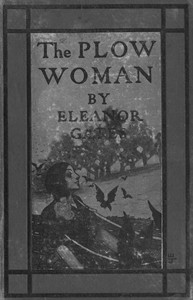The Plow-Woman by Eleanor Gates
"The Plow-Woman" by Eleanor Gates is a novel written in the early 20th century. This work chronicles the experiences of Dallas Lancaster, a determined young woman adapting to life on the Dakota prairie in the face of challenges that come with homesteading, family struggles, and the complexities of community life during a time of expansion in the American West. The story examines themes of resilience, responsibility, and the clash between the encroaching
railroad and the lives of settlers. At the start of the narrative, we meet Dallas, who is diligently plowing their new land with her mules, Ben and Betty, as winter approaches. The opening chapter introduces her family, including her father Evan, a crippled former railroad worker, and her delicate younger sister, Marylyn. The family's hopes hinge on their claim's potential value because of the imminent arrival of the railroad, which Dallas worries will disrupt their hard-earned life. As Dallas handles her plowing and interacts with her surroundings, the narrative builds a sense of both the arduous labor required for homesteading and the subtle shifts in their circumstances, foreshadowing conflict that may arise from their precarious position in the frontier. The arrival of outsiders, including a storekeeper named John Lounsbury, hints at evolving relationships and possible tensions in this tightly-knit community. (This is an automatically generated summary.)
Read or download for free
| How to read | Url | Size | |||
|---|---|---|---|---|---|
| Read now! | https://www.gutenberg.org/ebooks/31139.html.images | 595 kB | |||
| EPUB3 (E-readers incl. Send-to-Kindle) | https://www.gutenberg.org/ebooks/31139.epub3.images | 341 kB | |||
| EPUB (older E-readers) | https://www.gutenberg.org/ebooks/31139.epub.images | 349 kB | |||
| EPUB (no images, older E-readers) | https://www.gutenberg.org/ebooks/31139.epub.noimages | 316 kB | |||
| Kindle | https://www.gutenberg.org/ebooks/31139.kf8.images | 555 kB | |||
| older Kindles | https://www.gutenberg.org/ebooks/31139.kindle.images | 480 kB | |||
| Plain Text UTF-8 | https://www.gutenberg.org/ebooks/31139.txt.utf-8 | 533 kB | |||
| Download HTML (zip) | https://www.gutenberg.org/cache/epub/31139/pg31139-h.zip | 324 kB | |||
| There may be more files related to this item. | |||||
Similar Books
About this eBook
| Author | Gates, Eleanor, 1875-1951 |
|---|---|
| LoC No. | 06034690 |
| Title | The Plow-Woman |
| Note | Reading ease score: 84.8 (6th grade). Easy to read. |
| Credits |
Produced by Stephen Hope, Barbara Kosker, Michael and the Online Distributed Proofreading Team at http://www.pgdp.net |
| Language | English |
| LoC Class | PS: Language and Literatures: American and Canadian literature |
| Subject | Dakota Territory -- Fiction |
| Category | Text |
| EBook-No. | 31139 |
| Release Date | Jan 31, 2010 |
| Copyright Status | Public domain in the USA. |
| Downloads | 252 downloads in the last 30 days. |
| Project Gutenberg eBooks are always free! | |

